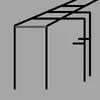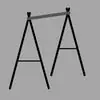This post should serve as a comprehensive categorization of pull-up equipment as well as a guide helping to choose the best pull-up bar for your home gym in each category. While I have written extensive reviews about a variety of pull-up bars already, here I aim to clarify the key attributes that differentiate one style from the other and the most optimal way to use them.
Along you’ll find my top category picks for you with a link to further analyze them with their runner-up peers.
Let’s get to it.
Pull-ups; What’s in it for You?
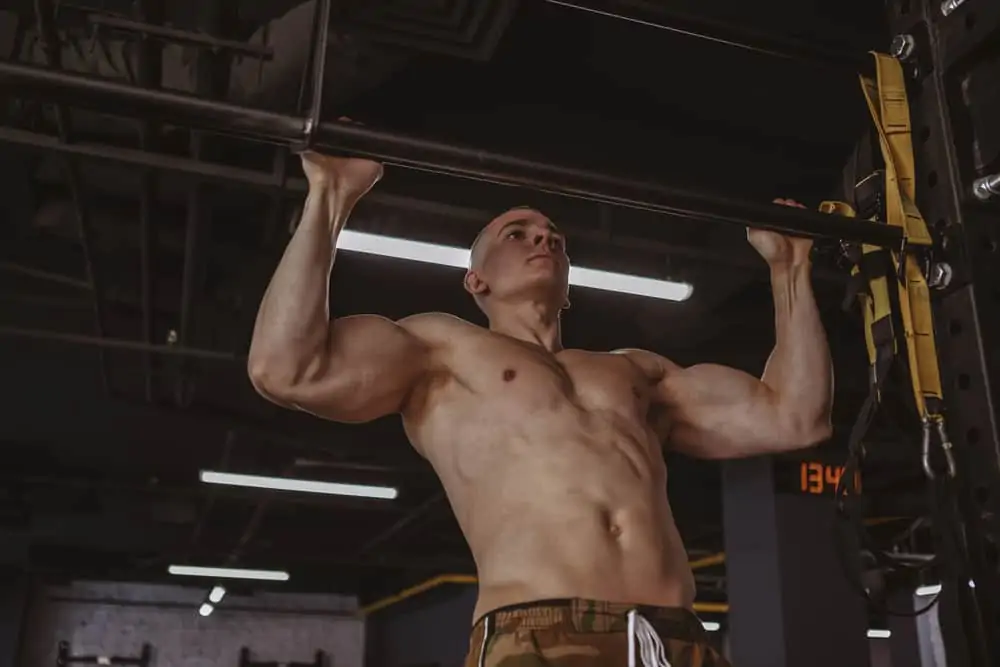
While as a kid most of us were able to do pull-ups, almost naturally, by adulthood it changes dramatically, unless you stay in the groove. Pull-ups are considered by many as the most challenging bodyweight exercise, though not surprisingly it is also the one that yields the most results as far as upper body strength and aesthetics are considered, hence all the hype about it, and I mean it in a good way. Why though?
Because pull-ups:
- Are very intense, strengthening the big guns:
- the v-shaped latissimus dorsi aka lats,
- the biceps, and yes, the triceps too,
- the rear deltoids and the rotator cuff,
- the spinal erectors as well as the rhomboids, trapezius,
- the pectorals,
- and done strictly the abs, such as the obliques and rectus abdominis aka the six pack
- finally, the forearm.
- Create full-body tension, from your fist all the way to your calves and therefore promote the synergic cooperation of body parts as opposed to isolating muscles which is rare in human motion.
- This recruitment of other muscle groups makes pull-ups very energy inefficient and although not a conditioning exercise, it could easily make you look more jacked by it’s strong muscle building potential, as the same amount of fat stretched on more muscle creates a leaner impression.
Of course, you could write a whole book about the benefits of pull-ups, further elaborating on the postural and neural improvements (and longevity to say the least), however, this short list should be enough to lure you into joining the wide group of pull-up proponents.
Common pull-up bar categories
It’s easy to get lost in the myriad of pull-up bar styles, or worse, buy one just to find out a day later that there’s an option that would have suited your apartment better. What’s not helping either is that each manufacturer tries to put a unique twist, a useful feature in their product design, which may turn out later to either prove useful or totally unnecessary.
In this upcoming section, I collected all the main pull-up bar categories for home use and highlighted their advantages/disadvantages.
Free-Standing Pull-Up Bars


This gym equipment is the real deal when it comes to pull-ups. A free-standing pull-up bar is the safest option for bodyweight and calisthenics training because it doesn’t have to be mounted, with no loading of the walls, ceiling, or doorframe.
It stands on the ground on its own, you can put it wherever you want, with plenty of space around the bar so it won’t block any movement as opposed to a wall-mounted pull-up bar that’s too close to the wall in case of short spacers. Not surprisingly, standalone pull-up bars are the go-to choice of outdoor fitness parks, playgrounds.


Pros
- The construction only loads the ground.
- It gives the most freedom for pull-ups and calisthenics exercises using all planes of motion.
- Most of them are complex power towers with a built in dip bar, leg raise elbow and back pads, and parallel pushup bars.
Cons
- With some cheaper models lateral stability is an issue (think of more vertical angled TRX attached inverted rows).
- Takes more space than other pull-up solutions.
Considerations
Utmost stability and safety have their price in terms of space required. The reason you might want to invest in a pull-up station like this is to have more room for your exercises—typically calisthenics, that has you extend your body in all planes—without risking stability. Therefore it might be overkill for a tiny apartment.
Also, the term, free-standing pull-up bar can be interpreted in many ways, and as mentioned, it’s a broad term for any solution that stands on its own. Since more complex power towers, power racks, and squat racks usually all include a pull-up bar, they can be considered free-standing pull-up bars as well. And rightfully so.
Since a rack like this probably won’t be placed in your living room but rather in a garage, the more complex your pull-up tower is the better, hence my top recommendation below.
Editor’s Choice Free-Standing Pull-Up Bar
With a few accessories like squat pins, dip attachment, and a weight bench, a free-standing pull-up station can be pimped up to a functional gym, with which you can cover all the main strength exercises, like squats, bench press, dips, and naturally, pull-ups.
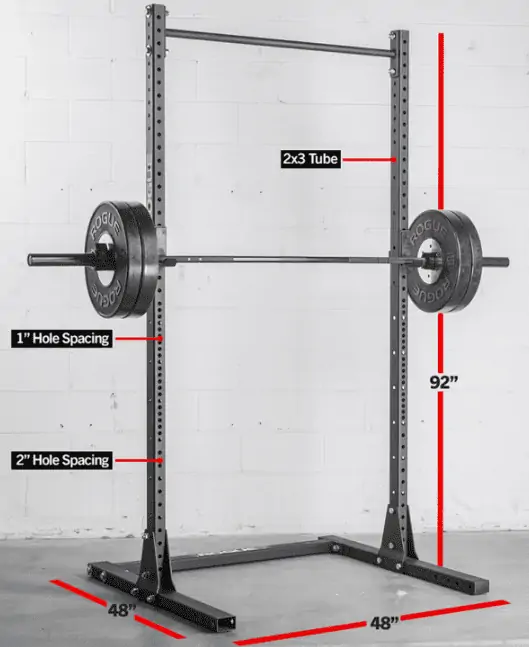
My top pick in this category for a round home workout would be the Rogue S-2 Squat Stand. Don’t be fooled by the name, it’s a perfect station for pull-ups, easily leaving behind cheap mono-pull-up alternatives with light aluminum frames and foam-covered grips.
Its sturdy construction, 1″ and 2″ hole spacing, great versatility, and a variety of Rogue accessories like a landmine attachment, dip bar, plate storage pins, bar holders, etc. make the Rogue S-2 a piece of very powerful equipment. Probably the only station you need for your home workout.
Wall-mounted pull-up bars
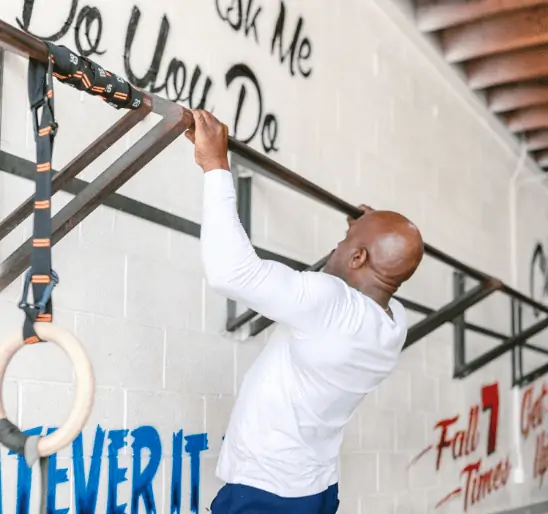
These are one if not the most common types of pull-up bars out there, popular amongst garage gym owners and Crossfit joints alike.
Securing the pull-up bar to the wall will spare valuable floor real estate for other exercises. Wall-mounted pull-up bars are therefore considered a space-efficient solution.
They are also the sturdier ones. The two most common designs they come with are T-shaped and L-shaped frames, the latter also having a crossbar for a more rigid structure forming a triangle when viewed from the side. Due to this added stiffness, L-shaped wall-mounted pull-up bars, in general, are considered more solid options over T-shaped ones, though this highly depends on material thickness and quality welding.
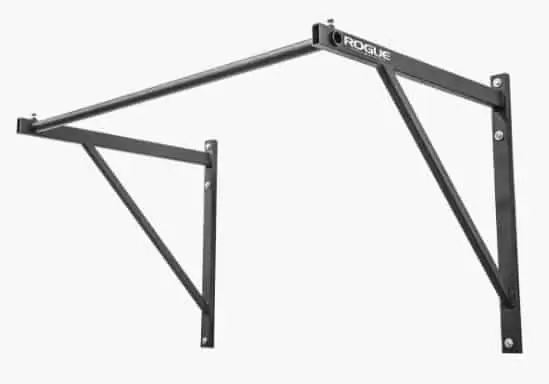

Pros
- One of the sturdiest and safest constructions.
- Space-efficient solution compared to other pull-up bars.
- Multifaceted use.
- They are fairly priced for their versatility, great value for the money.
Cons
- Mounting to the wall may require extra reinforcement depending on the weight-bearing capacity and thickness of your wall.
- They can still be bulky for a neat apartment or a tiny livingroom.
- Once they are secured to the wall they can’t be moved and stored away.
Considerations
A wall-mounted pull-up bar is a serious home gym equipment investment and usually reflects and presumes an already dedicated individual to fitness.
It is though rarely a choice of complete beginners, however, I would still highly encourage anyone in doubt to invest in a quality piece as it’s going to bring in its price easily over the years.
With no loose parts to tighten, it literally doesn’t require any maintenance. An initial prudent effort to secure on the wall is usually also the last occasion you need to touch the bar other than for pull-ups.
Editor’s Choice Wall-Mounted Pull-Up Bar
As this purchase may be a lifetime investment into your health and fitness and also because you want to avoid any accidental injury buying from a reputed manufacturer is highly recommended.
Quality grade steel and professional welding is what you should look for possibly from a factory dedicated to sports equipment manufacturing.
With this regard, the Rogue P-4 Pull-Up System is hard to beat. Rogue is the highly reputed manufacturer of garage gym products, also niching down on a variety of home gym equipment, and perhaps most importantly is the official supplier of the Crossfit Games, the most formidable fitness competition there is today.
If someone, they have a knack for heavy-duty and all the extra features top athletes and gym owners demand, not missing on the details like quality finish and knurling for the best grip, just to name one.
Ceiling-Mounted Pull-Up Bars


In case your walls are not weight-bearing, or you don’t want to constantly bypass a free-standing station, mounting a pull-up bar to the ceiling is the next logical idea.
Ceiling-mounted pull-up bars are much like wall-mounted versions, actually, they are quite the same. This is one aspect that provides their edge over other pull-up designs. If later you move to another place you don’t have to invest in a new piece, you have the flexibility to just flip your pull-up bar and use it either on the wall or on the ceiling.
What’s more unique to ceiling pull-up bars is the extra legroom, even sideways you can swing around as there are no beams. That provides more freedom, even over free-standing pull-up bars, with regards to your calisthenics exercise selection.
Pros
- Unlimited legroom and room for your body to freely move around the bar.
- Can be used interchangeably, either mounted to ceiling or wall.
Cons
- Your ceiling might need extra reinforcement.
Considerations
Choosing a bar with short spacers, aka short bar height, might prevent you from fully extending on top of the bar, as there won’t be any room for your head. A typical example would be doing muscle-ups or hanging upside down with your legs up.
Also, it might take a little bit of DIY to safely install a ceiling-mounted bar. Unless you’re drilling into a concrete ceiling, it’s not just the bolts that should hold the structure drilled in a few inches deep as the wall could rubble and eventually, lose the dowel.
If your attic is accessible, you should install wooden beams on the other side of the ceiling, and secure the bar to them through the wall. The added beams should provide plenty of surfaces to evenly distribute the weight on the wall instead of hanging on a few screws.
My Top Picks
My go-to pull-up bars for a ceiling mount is—not surprisingly—, from Rogue again, the P-5V and P-6V Pull-Up Systems.
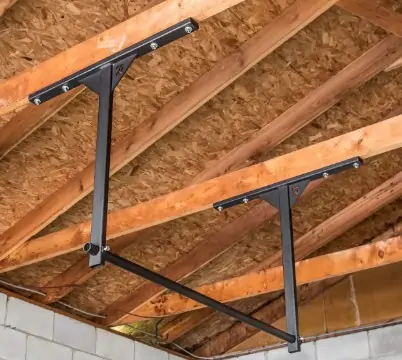
The only difference is that the latter has a longer support arm than the P5-V.
In the P-5V, you can place the pull-up bar either 14″ or 22″ away from the bracket, while the P-6V has a fixed arm length of 30 inches. It’s up to you how much headspace you need over the bar.
Both bars are weight tested with a capacity of over 500lbs, using extra stabilizers to support the steel notes you attach the bar to.
Doorway Pull-Up Bars


There are times when you just need a piece of something to hang onto, to stretch, to secure bands or a TRX on it. Maybe a swing for your kids.
For anything more serious, I would not recommend a doorway pull-up bar unless you are a kid or very lightweight, or if you have a steel doorframe. These bars usually have many design flaws it’s just not worth the hustle. The thousands of bad reviews support my opinion.
If you’re an advanced athlete you need more serious pull-up equipment. While if you just started out your home training, an initial bad experience might undermine your momentum.
However, to offset this negative entry a little, actually, there are cases when a doorway pull-up bar is a decent solution, when your door, its frame, and your chosen bar perfectly fit together.
This requires prior careful planning and measuring to spare headaches and bucks wasted. The upside is that if everything goes well, even a doorway pull-up bar can be a “life-saver”, as any pull-up is better than no pull-up.
Pros
- Lightweight
- Portable
- Cheap
Cons
- Not all doorways were designed the same, so it’s very rare that your bar fits as smoothly as planned and as claimed by the manufacturer. Surely their demo always present perfect scenarios and the only doorway the bar would fit to.
- Headspace is often compromised depending on the ceiling height.
Considerations
Most doorway pull-up bars rely on a tiny bit of detail. That’s, whether the bar’s splint can wedge with a snug fit against the slightly protruding trim of the doorframe.

If that verge is wide enough you’re in luck. Make sure to check this.
In some rare cases when your doorframe is too wide, the ends of the bar that stand against the side frames might only catch into the frame slightly. Therefore always measure the width of your door carefully and leave at least a couple of inches for the bar to stretch over the frame for enough stability.
The point of contact of the bar and the sides of the frame is another critical element. Many people complain of stains and even crackings, especially if your door is of softwood, like pine. Consider putting extra padding on these parts that even out the pressure.
Are door pull-up bars safe?
The issues are not so much about the quality and build of these pull-up bars. On their own, they stand their ground. Problems rather arise when mounted to the doorframe, if you are prone to yanking when doing a pull-up, the bar could loosen and slip out of the door wedge.
The safest way to use doorway pull-up bars is controlled smooth repetitions when a constant downward force is applied to the bar, ensuring the tight-fitting of the support points.
Therefore, leg swinging and yanking are not recommended, as you not only risk falling off, or hitting your head with a detached bar, but possibly damage your doorframe as well, as the bar could tear off the wooden frame. The piquancy of the thing is that it’s typically beginners who use all kinds of body language during their repetitions and they happen to be the target group of this equipment.
Recommended Doorway Pull-Up Bars

From the traditional ones, I would go with the pull-up bar from Ultimate Body Press. This bar is further away from the door so your head has enough clearance and is wide enough to fit most doorframes.
An alternative solution—though my personal favorite—, is the Rogue Jammer Pull-Up Bar. This bar is not in any contact with your doorframe but on the downside, you have to do some drilling to secure it to the wall, and therefore it has similar considerations as for wall-mounted versions. However, since it has to be placed above the doorframe, it requires less space between the wall and the bar itself.
Hence ideal for an apartment you don’t want to necessarily turn into a gym “rathole”.

Though your movement options would be more limited compared to a wall-mounted setup. Where the Rogue Jammer shines is really just pull-ups, but that it does very well.
Gymnastic Rings
Gymnastic rings are my true favorite. If I was to pick just one piece of equipment for my upper body training, it would be a pair of wooden workout rings, as it has so many benefits for such a low price.
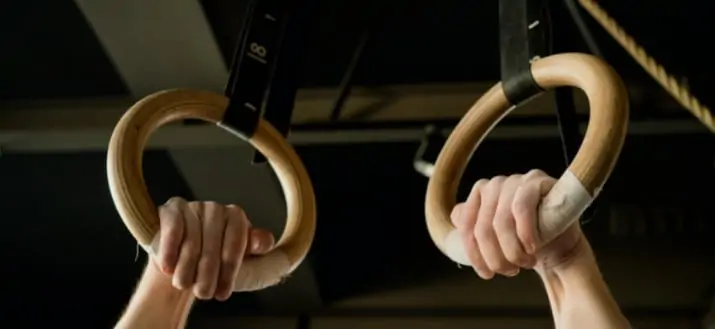
If you are a real bodyweight training aficionado gymnastic rings could replace many tools that are only designed for one exercise. And while I’m all for quality, and dedicated tools for exercises, when it comes to home workouts, as I always say, versatility is of utmost importance.
Gymnastic rings work as if you combined a pull-up bar and a dip bar with a suspension trainer. There are immense exercise variations that are otherwise impossible with the latter:
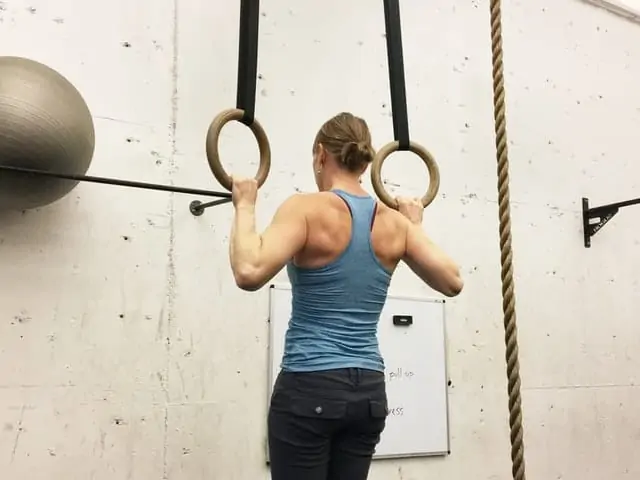

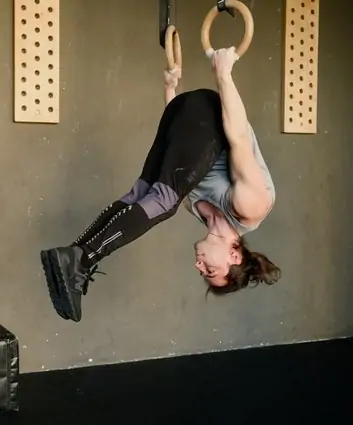

Pros
- As far as bodyweight workout goes, rings provide the most opportunities for exercise variety. You can independently set the straps from each other, which allows you to perform dips/pushups/pull-ups, normally impossible with most suspension trainers.
- The free rotation of the handles lets your shoulders move more naturally, rings are therefore a more shoulder-friendly option over bars.
- The instability of a gymnastic ring promotes more muscle activation and body awareness.
- Rings are dirt cheap compared to free-standing or other pull-up bars.
Cons
- Because of the instability, a few ring exercises might be too advanced for beginners, like dips and pushups.
- You can’t hook your legs in a flexible stirrup that most suspension trainers have.
Versatility king
- Ring pull-ups
- Ring dips
- Ring muscle-ups
- Ring inverted rows
- Ring pushups
- German hang (skin the cat)
- Inverted hangs
- Face pulls
- Bicep curls
- Tricep extensions
…and the list goes on
Considerations
The most important aspect, in my opinion, to keep in mind before buying a gymnastic ring is the fact that you’re probably going to move it around a lot. Exercise variety is great, so are supersets and giant sets when you combine a few exercises and keep doing them back and forth in rotation.
However, constantly changing and re-adjusting the strap length and width of a gymnastic ring could really interrupt your flow and becomes annoying over time. Not to mention wear and tear that accumulate over time caused by the teeth of cam buckles.
That means you either buy a few more pairs of rings so that you can leave them adjusted in one position for your favorite exercises or buy numbered and looped straps with a carabiner for easy adjustment and durability.

Another minor practical flaw is that, unlike most suspension trainers, you don’t have the option to hook your legs in a soft, comfortable stirrup for exercises like planks, pikes, mountain climbers, supine leg curls, etc.
The Best Gymnastic Ring
Any kind of gymnastic ring is better than none. Though my top pick is one that comes with straps with quick-adjust looped anchor slots and carabiners. The Double Circle Wood Ring features just that.


With natural wood grips and a whopping 1100lb capacity in pairs, this is the perfect combination for a ring workout. Find my more detailed review of this product in my ceiling-mounted pull-up bar comparison post.
Outdoor Pull-Up Bars
The main issue with any outdoor sports equipment is corrosion. Therefore, leaving a pull-up bar out in your backyard for long is not a good idea, unless it was designed to withstand those conditions.
The main feature that sets outdoor pull-up bars apart from regular ones is their weather-resistant finish, including UV protection.
Also, most outdoor pull-up bars that you would come across in calisthenics and fitness parks are free-standing pull-up bars, monkey ladders, with two bent poles secured in the ground with concrete.

The advantage of such outdoor pull-up bars designed for calisthenics parks is their extreme rigidity and sturdiness. There’s not even the slightest wobbling, regardless of your bodyweight or added extra weight.
What makes their surface bulletproof against weather conditions is also the reason why—depending on the season though—you would hate to work out with an outdoor pull-up bar.
During summer if your outdoor pull-up equipment is exposed to direct sunlight, the metal gets scorching hot.
While during rain and/or snow/ice your grip is severely compromised to the point when it even becomes dangerous to work out.
It’s punishing enough to train outside in such conditions already, so as with everything fitness-related, weather can be a b*tch and you may not be able to use your expensive backyard gym equipment as much as you want to.
Common Outdoor Fitness Equipment Coatings
Polyester and polyurethane coating: excellent weather resistance, but it has the slippiest grip of all. Still the most widely used coating for outdoor fitness parks.

Galvanized: using zinc oxide, galvanized bars mainly protect against corrosion, hence a very powerful finish against elements. However, less suitable for decorative purposes, and as such not that widespread in the fitness industry. The grip is okay.

Powder-coat finish: offers very good grip, but is better suited for indoor use. Probably the second most common finish within the fitness industry, next to chrome, because it’s easy to produce in a variety of colors and textures.
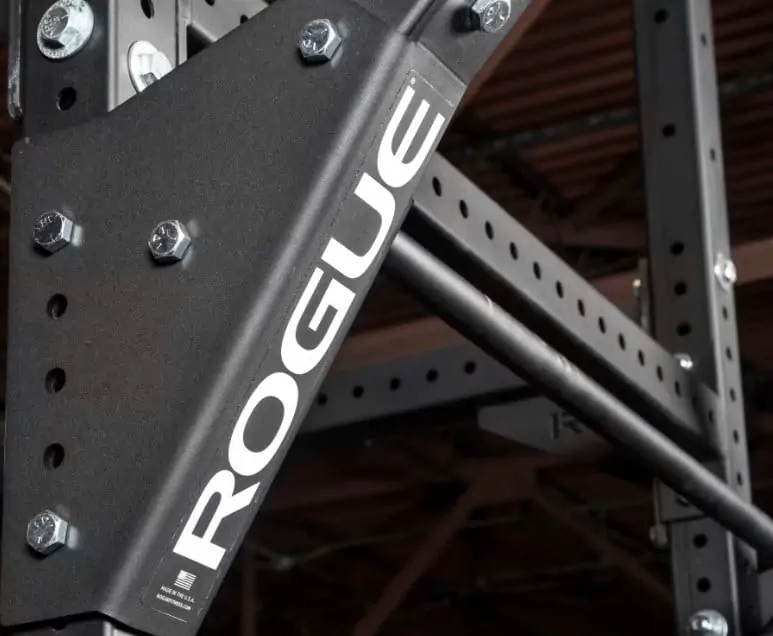
If you want the best of both worlds, galvanized products with powder coat finish provide the best overall outdoor fitness experience, especially where grip is important as the case with pull-ups.
Considerations
An outdoor pull-up system is most practical if it has a fixed place. While you could take out your gear in your backyard every time before your workout, frankly, it’s not convenient.
So usually with outdoor fitness gears, part of the investment is:
- a level surface where your pull-up gear will be placed,
- a canopy, saletli, or any kind of roof, to both protect your equipment in the long run and to make your workout more bearable in case of rain or blazing sunlight.
Also, obviously, you have to make sure that there’s no place for water to sit for a prolonged time in contact with the metal frame. A critical point where your outdoor pull-up equipment is most exposed to corrosion is where the bars are connected to the ground, in the hole, or at the base. While other parts of the frame dry off quickly, stagnant water at the base can kill even the toughest coating. So it makes sense to plant your pull-up frame on a surface that slopes slightly from the structure, draining the water away.
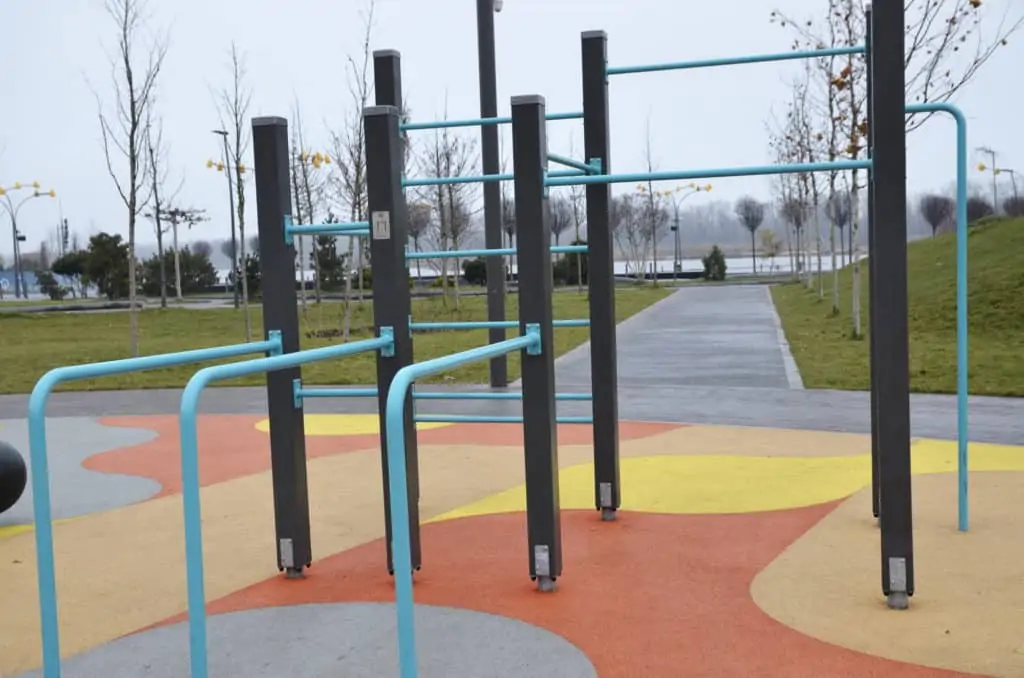
In case you do your outdoor fitness backyard yourself, not just the bar but any accessory parts have to be corrosion resistant as well, like screws, bolts.
Needless to say, any nonmetal, non-plastic material is even more exposed to the elements. For example, if there’s any textile material, like a suspension strap or textile pieces used for padding, mold and UV will be the two main detrimental factors.
All of the above could mean extra expenditure in addition to the already higher cost of special coating of the frame.
Editor’s Choice Outdoor Pull-Up Bar
Due to the specific demands, finish, and materials, outdoor pull-up bars in most cases are built for a custom order, while ready-built systems are quite rare.


However, I find that the Stamina-Power Tower represents a great value for the money, in terms of durability, stability, and versatility.
Designed for outdoor use, the Stamina pull-up tower is corrosion and UV resistant. You don’t have to take it in and out every time you workout, you can just leave it in your backyard.
It’s also stable enough so you won’t tip over, a major consideration with free-standing pull-up bars.
Foldable Pull-Up Stands

As the name suggests, a foldable pull-up bar is one that you may assemble quite frequently before your workouts because there’s no permanent place for it in your apartment.

The frame is built pretty much like a kids’ playground swing, a stepladder, or a trapeze stand with 4 legs and a pull-up bar on the top connecting them. Adjusting the height is usually as easy as pulling the legs away from or pushing them closer to each other, based on the same mechanics as a scissor lift.
Should you be taller, there are often adjustable tubes that slide in each other in addition to the scissor mechanics to raise the frame higher.
Pros
- Provides enough stability for pull-ups, even muscle ups.
- Lightweight but strong, mostly using alloy steel frame.
- Easy to assemble, foldable construction.
- Height adjustable using safety pins and distance setting bars.
- Plenty of sagittal space under the bar for other exercises like TRX inverted rows
Cons
- They can take some space, even folded.
Considerations
If you’re an old-fashioned and/or hardcore lifter, a foldable pull-up bar likely won’t cut it. Weighted pull-ups although possible, are not what these structures were designed for.
Talking old school, most foldable pull-up stands have foam handle grips that wear off quickly or just the bare painted alloy frame that doesn’t allow as secure a grip as a powder-coated frame.
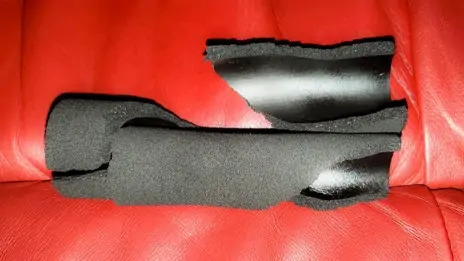
Also, if you’re looking for an all-around multipurpose pull-up bar, you might miss the dip handles, which are rather unique to power towers, and racks.
Recommended Foldable Pull-Up Bar
The Khanh Trinh free-standing foldable pull-up stand cemented its name in the home workout category as a flexible solution for storage and assembly issues.


You can store away this pull-up gear relatively easily, and assemble it any time you need without sacrificing function and stability.
It is made of lightweight alloy steel and is height-adjustable using both sliding tubes and distance setting bars to control how wide apart the legs go, thus the height of the bar.
This foldable pull-up bar is strong enough to even hold a 770 lb dude, who is well over 6 feet tall (6.56 ft to be exact).
What I like the most about this scissor lift-like solution is that you can do kipping pull-ups, leg raises, you can even attach a kids’ swing, there’s plenty of leg space, nothing in the way as opposed to common power towers.
The Khanh Trinh is a highly rated pull-up stand with many satisfied customers. I much recommend it in case you’re looking for practical home workout equipment.
Portable Pull-Up Bars
This next category embodies the tiniest of all pull-up home gym equipment. It includes any practical solution that is taken out of your suitcase quickly and lets you do your pull-up workout should you travel anywhere in the world.
The most iconic and evident product of this category would be again, gymnastic rings, as they are so versatile, and light they happen to be the best portable gym workout tool as well.

But let’s suppose you want to go a step further and really specialize in just pull-ups. The only downside of rings—namely that you need to have something to hang them up to with the straps, a hook in the ceiling, a tree branch, you name it—now becomes an exclusion factor.
Since you can’t drill holes in the ceiling in all the apartments you temporarily live in, you need something even more simple than gymnastic rings. What do most homes have? Doorframes.
So the next generation of portable at-home pull-up gears is really just clamp-like grips attached to a doorframe. This can save your vacation and spare you from muscle loss by making the king of bodyweight exercises available to you in most apartments of the world. Khm…. that has the right doorframes, but more on that later.
Recommended Portable Pull-Up Bar
To have an idea of what the smart marketing people came up with this time, here is my best bet if you find yourself in a situation where you can’t break your pull-up routine and need to exercise in any accommodation, hotel rooms, apartments, and wherever you travel.
Well, in this case, the Duonamic Eleviia, (claimed the world’s best portable pull-up bar), won’t let you down. It takes less than 8 seconds to take out from the box and install this beast upon a doorframe thanks to the spring that keeps the clamp locked securely to the trim of the doorframe.


A blend of nylon and fiberglass ensures a very lightweight but strong and durable material, that supports pull-ups up to 250 pounds.
Due to the spiral springs, the clamp is secured to the doorframe automatically which literally takes two seconds. You just need to pull the stems apart.
The connecting points are covered with soft thermoplastic so it won’t damage most doors.
Too bad the tube grip is attached to the clamp with a string, which may cause the tube to slide resulting in an uneven grip between the two hands.
The other downside would be the lack of headspace that is all too common with doorframe-attached pull-up bars. Since this portable pull-up clamp is designed for such use, it may force you to use a partial range of motion or to alter your form into too much extension of your chest.
Anyways, the Duonamic gear can be your best travel pull-up tool designed with the busy manager in mind.
Portable Pull-Up Bars Considerations
The most important thing to balance here is if you travel enough to really make use of a clamp-like portable gear. As much as they are handy, powerful tools, they have severe limitations and can’t replace regular, solid-structure pull-up bars.
One of such limitations is what I already mentioned above, that the door trim has to be strong and wide enough to allow the safe attachment of a clamp-style bar topped with your bodyweight hanging from it.
Also, specificity comes at a price and such products do take advantage of a coercive situation wherein without a better solution, you just go with any gadget that allows some form of a pull-up.
Top it with compromised form, and you have a serious case against such deals, however, from here it’s rather personal and only time can tell whether portable pull-up bars will be a real thing in the future.
Tree-Mount Pull-Up Bars
This is not really a category in itself yet, but since gardens and backyards are becoming increasingly popular home workout environments, tree-mounted pull-up bars as such can be a great option for those who have favorable circumstances.

There are not many options in this category, in fact, the Pullup & Dip bar is the only dedicated tree-mountable pull-up station as far as I know.
Sure you could hang a gymnastic ring from a tree branch any time, but hanging up a pull-up bar was way trickier…to this day.
The Pullup & Dip guys did it, and while it’s not the “quickest to attach” pull-up bar, it certainly lets you do flawless pull-up repetitions, unlike portable or some doorframe bars.
The fact that you can do dips as well makes it even more practical.
But its true versatility lies in its mounting options. See diameter at the end doesn’t matter that much, since you can mount this pull-up bar to a big wide trunk, a smaller tree, even to a tiny thin post. And to a wall as well.
With a 330 lbs max weight capacity, the structure is strong enough to hold most individuals, provided your tree or post is up to the task. And funnily, this whole thing can be demounted and fitted to a backpack.
Anyways, I’m sure as home training continues to gain ground, tree-mountable pull-up bars will be a thing, heck, this piece is surely on my bucket list.
At Home Pull-Up Bars vs Commercial
Unfortunately, there is a distinction between gym equipment made for casual, home use and for professionals or for a commercial gym where hundreds of people abrade it daily.
However, you don’t have to jump on this wagon and blindly consume what’s put in front of you. In general, when it comes to your home workout you are almost always better off with commercial-grade equipment and not with the one that is designed for home use.
Most gym gears are designed for generations to come, hence are made of steel. Pull-up bars are no different, just because you’ll use one at home, doesn’t mean a measly piece is good enough.
That’s because usually, the price difference you pay for a more expensive commercial gear is not proportionate with its durability and worth. Almost every time you get more quality than what you pay for, as commercial gym equipment like pull-up bars, kettlebells, racks, and stands can withstand a lifetime of abuse.
It’s just not worth sparing a few dozen bucks in favor of a plastic stick held by two screws in a soft pine doorway “designed for pull-ups”.
Whenever you can, go with heavy-duty professional gym equipment made of steel or lighter, but stiff alloy. With a few exceptions like power towers, power racks, etc. most equipment that’s good for a busy gym will also be good for at-home use. The extra bulk—if at all—, in many cases is negligible.
So what are the best pull-up bars for an apartment?
My recommended pull-up bar for most people living in an apartment is solid steel, powder-coated wall-mounted bars. For brick and concrete walls, they provide the most in terms of stability and usability.
Should you have thin walls with no weight-bearing ability, like plasterboards, I would recommend a ceiling-mounted pull-up bar, though, for your information, most wall-mounted versions fit this category, you just need to flip the frame 90 degrees (check Rogue’s P-4 Pull-Up System).
Which Pull-Up Bar is Best for Your Fitness Level?
I mentioned before that although doorway pull-up bars are often regarded as the go-to gear for beginners, practically that’s not the case.
There are many reasons why wall-mounted pull-up bars suit beginners best:
- They allow to build a solid foundation with pull-ups first. Hence wall-mounted bars are the perfect middle ground between doorway and power towers or free-standing pull-up bars.
- They take less space than free-standing models.
- Beginners don’t take advantage of the extra exercise variations a free-standing pull-up station or a foldable stand allows.
- They are more solid, reliable and safer than doorway models, also often come with better grip.
- They fall within quite similar price range than doorway models.
For advanced athletes with more exercise variety, free-standing pull-up bars are recommended, as they offer flexibility that satisfies their needs in the long term. As such, for home use, a strong foldable pull-up bar would be my second best choice for practical reasons.
Most Common Pull-Up Bar Accessories
A pull-up bar is a great home workout tool of its own, but you would miss out on many benefits if you hadn’t equipped it with pull-up accessories that you could live without, but why though? 🙂
Here’s a list of the most useful tools to add to your setup:
- Dip bar (for power rack and pull-up stands).
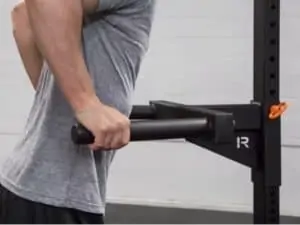
- Grip strength and grip variety: pull-up globes/balls, spheres, neutral grips, ropes, pinch blocks.
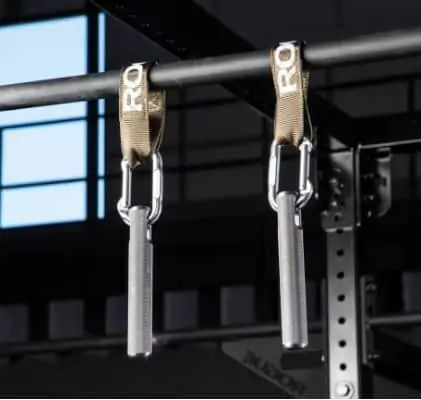
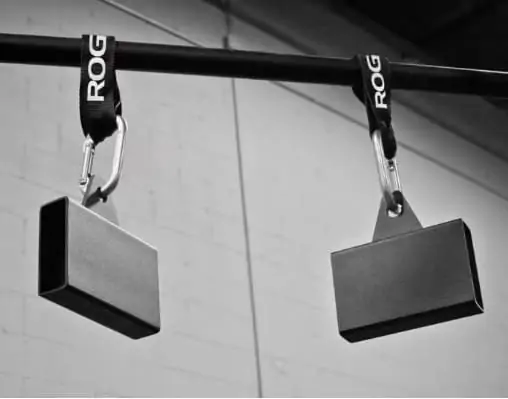
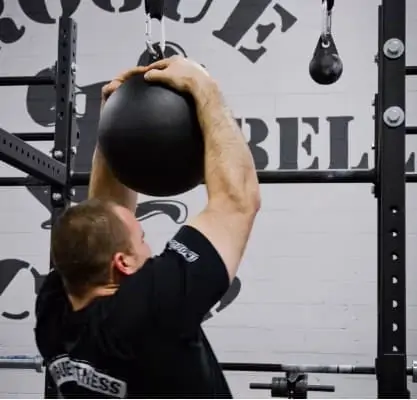
- Storage and hanging: shackles, loops, hangers, pulley system, punching bag, band attachments
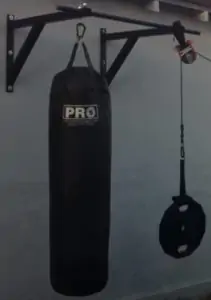
Best Pull-Up Bar Substitutes for Home
There are situations when no matter how much you want there’s just no place for a pull-up bar in your home. Either because it doesn’t fit the interior, or you have no weight-bearing walls, nor space to mount a pull-up station.
During this Covid pandemic, many people were forced to stay and workout in their homes. And one, if not the most critical element they had to come around is the lack of a pull-up bar, that is vertical rows.
If you are amongst the many who just could not find an appropriate way to fit a pull-up bar to their homes, there are great alternatives that don’t require such a setup but still yield specific stimulus to the pulling muscles that translate nicely into pull-ups.
The following essential home gym equipment and exercises are all very useful in substituting a pull-up bar:
- Dumbbells: For single-arm dumbbell rows, pullovers.
- Suspension trainers: TRX inverted row.
- Kettlebells: For any deadlift variations, which are basically pulls.
- Ab wheel: Doing abwheel is pretty much a pullover exercise, which is a great move to strengthen the lats for pull-ups.
In fact, I had clients who worked their way up to their first pull-up without ever doing one before just performing a ton of horizontal rows and deadlift. It may not be the fastest way, but a steady, safe and strong path in getting the key muscles strong enough to handle your bodyweight when you get to pull-ups.
If you have heavy enough basic equipment like dumbbells, or even just scale suspension rows progressively you should be able to get to pull-ups even without a pull-up bar in your home gym.
Final Thoughts
As the need for home workouts expands rapidly, now there’s a certain type of pull-up bar for any scenario, for any house and apartment. Though the best pull-up bar is the one that you are willing to use frequently.
The most important criteria, therefore, is to decide where you’re going to workout and accordingly, what type of pull-up bar would best fit your home conditions. The less you have to assemble or move around gym equipment prior to training the more likely you’ll feel inclined to work out.
Therefore, fixed pull-up stations work best in the long run, however, they require the most planning and resources too.
If you’re looking for a light and compact solution, wall-mounted pull-up bars and/or gymnastic rings are still my go-to options.
Finally though, if for any reason you need a more exotic solution, now you have an exhaustive list of all the major pull-up bar categories available today.






